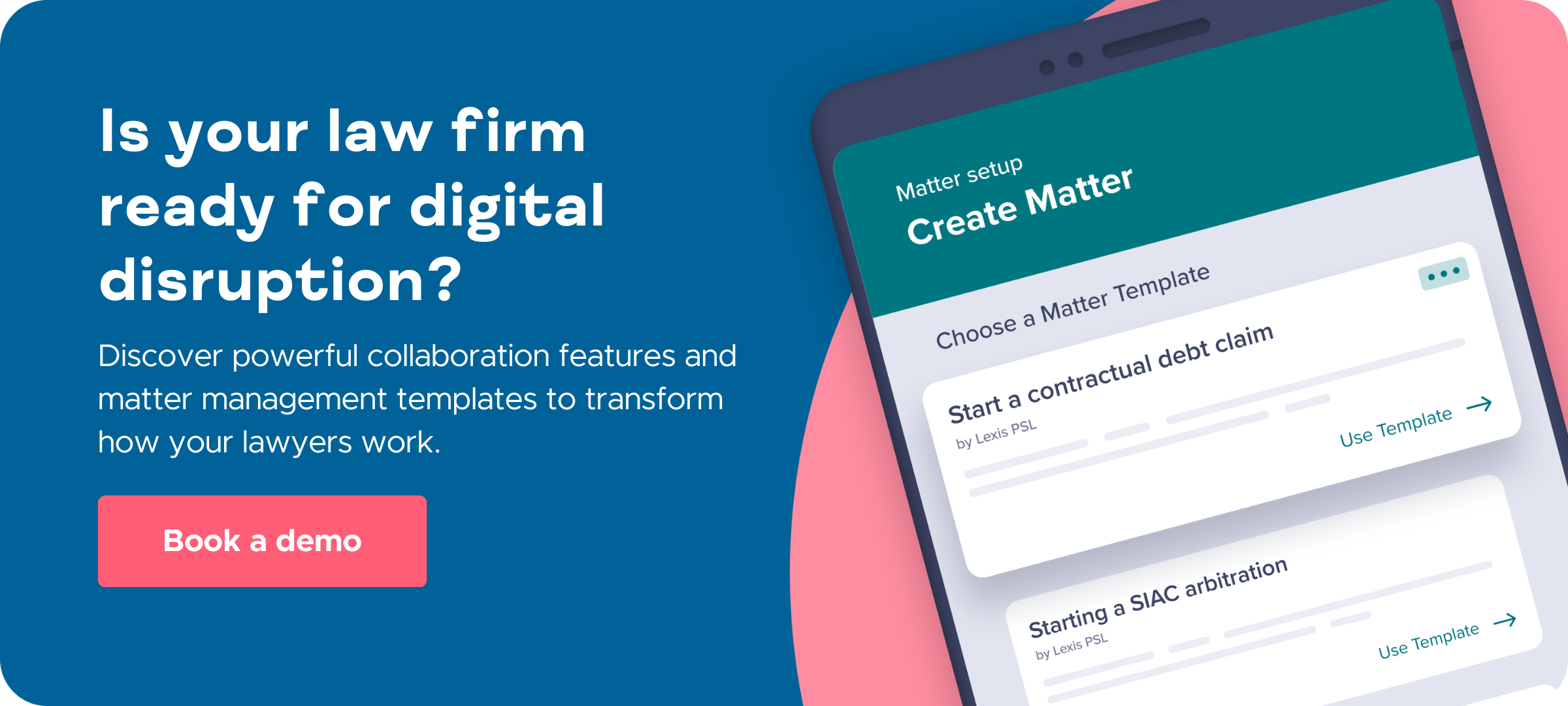5 Disruptive Legal Technology Innovations to Watch in 2023

Disruption. It’s not a word we typically associate with positive situations, but in the legal industry, it can be.
Unlike other industries, legal has been slow to adapt to the modern world. 86% of lawyers work outside the typical 9-6 hours.1 Meanwhile, only 70% of US law firms used cloud and web-based services in 2022, far behind the rest of the business world.2
In the race towards a tech-driven future, the legal sector is lagging behind. Disrupting this is a good thing. It’s helping drive innovation and growth, streamlining company operations and soothing work-induced headaches. Which is good, because legal professionals get a lot of them.
Disruption is coming. If you’re prepared, great. If you’re not, you might want to start doing your homework. Here are five disruptive technologies that you’ll want to know all about in 2023.
Suggested reading: Discover how to use legal tech to establish better processes within your company, streamlining your workflow and improving company-wide visibility.
1. Data, both BIG and small
The data landscape has changed massively over the last few years. Information that was once used and discarded is now a crucial component of ”‘big data”, ready to be analyzed for insights. Although “big data” is a term regularly thrown about in complicated tech blogs, it just means data sets that are too big for traditional processing software to handle.
The problem faced by many legal professionals is that they need to access evidence located deep within these big data sets, for example in:
- Text documents
- Videos and photos
- Diagrams
- Voice recordings
- Social media content.
So today, businesses are competing based on the speed at which they can trawl through vast swamps of data. Some legal firms try to avoid the swamp altogether, missing out on golden nuggets of information. Others allow their employees to dive into the swamp headfirst and are left with a demoralized, exhausted (and potentially muddy) workforce.
As much as traditional legal professionals might hate to admit it, being able to navigate big data is an important step towards improving business outcomes.
Luckily, the increase in big data has also led to an increase in legal innovation and technology, including a number of helpful eDiscovery tools. These disruptive tools automate the eDiscovery process, speeding up processing times and providing clients with reliable, accurate, and insightful data.
But it’s not all about big data. ‘Small’ data remains crucial too — just ask law firms who have suffered data breaches. When multiple software platforms are used at one time, weak points can develop and valuable files can be put at risk. New legal technology which brings these multiple software platforms together under one roof helps reduce these security vulnerabilities.
Lupl, and other software platforms like it, allow you to perform all your research and communication needs in one place. This kind of disruptive legal innovation allows companies to harness their big data, without the risks. The legal industry has two clear choices: swamp swimming, or software.
2. Artificial Intelligence
Data is one thing. But extracting information and gleaning insights from this data is increasingly being done using perhaps the bigger disruptor of all industries: artificial intelligence (AI).
AI has already caused a seismic shift in the workings of modern legal services, transforming research processes across the world. Much of this shift has been thanks to Natural language processing (NLP), a computer’s ability to understand text and spoken words, leading to the increase in chatbots. And as machine learning becomes more advanced, NLP is becoming more reliable.
The Law Society’s report into AI and the legal profession found plenty of ways AI will disrupt legal, including:
- Document scanning: Transforming the transaction process, where AI models solicitors’ thinking to draw out key findings from a document.
- Contract intelligence: Scanning and drawing out risks within a contract, displaying these risks on a dashboard in easy-to-view ways.
- Case outcome predictions: Having ‘read’ outcomes to previous cases, algorithms can predict the outcomes of other, similar cases based on legal precedent.3
Despite this, legal has often neglected the speed and accuracy of AI to complete these tasks, favoring more traditional methods of analysis instead.
So, why aren’t more law firms using AI? Simply, many firms haven’t fully grasped just how big this technological revolution is. Although AI may have been over-promised in the past, its current capabilities offer legal the opportunity to undergo digital transformation and improve how they work. Yes, it means change — to fee structures, business models and the workforce — but, done right, it can also mean improved client delivery.
And with law firm stress and burnout a common factor in the legal industry (more on this in a moment), using AI to complete more tasks can free up lawyers’ time, positively disrupting not just the work they do, but their work-life balance too.
3. Automation
Some people think the automation of legal services is a thing of the distant future. The statistics say otherwise. It’s estimated that by 2024, legal departments will have automated 50% of their work — and a large part of this growth is down to AI.4
AI’s ability to review and analyze legal documents, automate eDiscovery, identify relevant case law, and even provide advice on legal matters, has allowed it to quickly outstrip human competitors.
But futuristic AI and eDiscovery tools are only half of the picture. The other half is led by efficiency tools that enhance and support the processes already being undertaken by legal professionals.
A standard, non-automated process might look something like this:
- Make a new task.
- Create a checklist for that task, breaking it into its constituent parts.
- Delegate these parts and then keep tabs on each to make sure they are on track.
- Email documents and resend them each time they are updated.
- Complete the task, and start the process again.
Simple tools like matter templates can cut the processing time for tasks dramatically by having these steps automated and built into the template. Lupl’s legal matter management templates are set up and ready to go, based on the matter you’re working on so you don’t have to complete steps 1 to 5 any longer. Select the right template and get going. It allows users to store and edit information and assign and update tasks through a central space, streamlining company processes and reducing inefficiencies.
Embracing disruptive legal technology innovation doesn’t have to be as complicated as installing AI-driven search engines. It could simply mean implementing more effective data management processes that utilize the benefits of technology. As the legal sector reluctantly steps into a technology-driven future, we can expect to see more of these subtly powerful automations.
4. Burnout and mental health
Okay, it’s not technically a technology trend. But burnout and mental health is a trend that can be improved by disruptive legal technology. Lawyer burnout and poor mental health disrupts client delivery, sure. But it also affects lawyers themselves. And if they get burnt out, they leave, causing a cycle of burnout, turnover and dwindling quality of work.
Burnout — a state of physical or emotional exhaustion — can be the result of many factors. The main factors contributing to burnout include:
- Unmanageable workloads: Lawyers have lots to be getting on with, but the unmanageability is often the result of needlessly complicated processes and outdated working methods.
- Long hours: We’re not saying that people shouldn’t be working hard or full days, but without safeguards in place to prevent overworking, employees can quickly get overwhelmed.
- Demanding client expectations: The legal industry isn’t alone in having demanding client expectations, but these expectations have to be carefully managed to prevent employees trying to meet impossible goals, and getting burnt out on the way.
But disruptive tech aims to meet this challenge. 2021 saw a spike in tech that focuses on wellbeing because, according to consulting specialist Brett Burney, “that was the conversation happening” at the time, sparked by conversations on COVID, ethnicity and race.5 In other words, when people start talking about a challenge, technology rushes to meet it.
Lupl, a legal project management tool, helps to reduce burnout and mental health issues among staff by optimizing workloads and improving company-wide communication. We help you close the “loop” faster, providing 360-degree visibility of your personal and collaborative tasks. With the discussion of legal burnout and mental health issues gaining momentum, tools like Lupl are one to watch in 2023.
Pro tip: Lupl can help you organize your workspace to ease the pressure on your employees. And with a research assistant tool like Lupl Pins, where you can link information to one of your matter templates, you can easily capture contextual information, add descriptions, and share your findings with team members.
5. The Cloud
Yes, that old chestnut. The cloud has been threatening to positively disrupt legal for what seems like forever, but so far it’s almost all bark and no bite. While many law firms use the cloud for storing personal or client data, few have taken the leap to fully cloud-based operations.
In fact, in 2021, 70% of respondents reported that they used cloud computing, up from 60% in 2021. For solo [lawyers], cloud users moved from 52% to 84% in just one year.6 That is a huge leap in numbers from pre-pandemic days.
It’s easy to see why. With so many benefits of cloud-based systems, even the general lag in adoption in the legal industry can’t stop the change from coming. Benefits like:
- More storage: We’ve already discussed why big data is a chore. With the cloud, users can store larger quantities of data than ever before, and at lower costs.
- Better accessibility: Admins are able to control platform access, ensuring the right people have access to the right information.
- Time-saving: No more hours lost trawling through outdated storage systems. Find what you need quickly, and get back on track
- Enhanced security: With all your employees working on the same server, there’s no need to send documents externally, reducing the risk of data leaks.
Even with the increased risk of cybercrime, it’s hard to ignore the benefits for clients as well. From collaborative tools, increased transparency, and reduced costs, clients are expecting more from those representing them.
Lupl embraces disruption
Disruption doesn’t mean ripping your existing systems up and starting from scratch. It also doesn’t mean a silver bullet that will solve all the legal sector’s existing challenges. But what it does mean that there are things you do today to improve the efficiency and stability of your law firm for 2023.
Our advice to you? Start small. The macro impacts of micro innovations can be astounding. Disruption and innovation often means taking small, simple steps towards optimizing the everyday.
Lupl embraces this disruption. You can too. Book a demo today.
1 Study Finds Attorneys’ Work-Life Balance Out of Kilter, With 42% Working on Weekends
3 AI: Artificial intelligence and the legal profession | The Law Society
4 10 Trends in the Legal Tech Sector for 2022 | IE LawAhead
5 Can Legal Tech Aid Mental Health? Attorneys Have Gotten More Skeptical | Legaltech News
More legal tech insights we think you'll love

Q2 2024 Product Update – New Features & Improvement
Lupl is the leading task and project management solution for...

How a team of trainee lawyers streamlined work handovers with Lupl
CMS trainees adopt Lupl's task management tools to enhance work...




